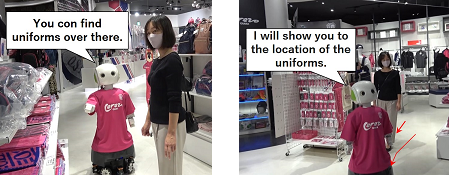Press Release

10 November 2020
Advanced Telecommunications Research Institute International (ATR)
Advanced Telecommunications Research Institute International (ATR)
Field trial of the shop assistant robot has started!
- The shop assistant robot will approach customers who are not wearing masks and ask them to wear one -
- Advanced Telecommunications Research Institute International (ATR) Co., Ltd. has started a field trial of a shop assistant robot that moves in the store and provides multiple services at Asia Pacific Trade Center (ATC) ITM Building Cerezo Osaka Mega Store.
- Not only supporting customer such as explaining and guiding the location of product that s/he is looking for, but also the robot provide a reminder service to the customer that did inappropriate behavior such as forgetting to wear a mask to ask for the customer's cooperation.
- We plan to investigate the effects of the robot through this field trial.

Fig.1 Examples of guiding service on the shop

Fig.2 Examples of reminder service for wearing a mask
Overview
Advanced Telecommunications Research Institute International Co., Ltd. (ATR) has developed a shop assistant robot that provides services while moving around the store. On November 10th, at Cerezo Osaka Mega Store (2-1-10 Nankokita, Suminoe-ku, Osaka-shi, Osaka), ATR has started a field trial of a shop assistant robot. It provide guiding, and reminder service (i.e it asked provide services, such as guiding and leading on the shop, and give a reminder to wear a mask depending on the situation of people (Figs. 1 and 2).
Background
The robot is expected as worked as a shop assistant in a retail stores due to labor shortage caused by the declining birthrate and aging population. However, the job of the shop assistant is not just to respond to customers’ request. It is also necessary to ask a customer who is behaving inappropriately for their cooperation. Especially in Covid-19 pandemic, the shop assistant remind to wear a mask when a customer forget it; it also remind to maintain social distance during lining up. During Covid-19, avoiding direct contact between people is desirable; and now expectation of a shop assistant robot is increasing.
Our robot
We have been conducting research to realize human-robot symbiotic society, in which robots work at our daily life to provide various services. As an example of a human-robot symbiotic society, we developed a shop assistant robot that moves around in an actual store and provides services to customers, and start a field trial.Not only “supporting customer” such as explaining and guiding the location of product that s/he is looking for, but also the robot provide a “reminder service” to the customer that did inappropriate behavior such as forgetting to wear a mask to ask for the customer's cooperation. Through the field trial, we investigate the effect of the robot service to find social acceptable design of shop assistant robot.
It is difficult to predict when/where/what kind of service is required. Thus our shop assistant robot automatically patrols the store to find the situation required services. To make safe navigation at narrow corridors in a shop, the robot used 3D map with 5cm grid to localize its position. With this functionality, our robovie explains the location of a product, and takes a customer to the location of the product if necessary.
In order to remind customers who have forgotten to wear a mask or who do not maintain social distance when lining up, the robot need to recognize people's situation. Using a camera and 3D LiDAR*1 on the shop assistant robot, it can detect such inappropriate behaviors during patrolling. When the robot find an inappropriate behaviors of a customer, it start to approach the customer to remind him/her.
Future Developments
Our shop assistant robot moves around the shop, and provide two different services: supporting customers, and remind a customer for cooperation when s/he does inappropriate behaviors. These robots are state-of-the-art and big challenges. During this field trail, we investigate the effect of the robot service and reveal the requirements of the shop assistant robot for its social acceptable design. We also plan to provide our findings and technologies to researchers and developers of the service robots.[Glossary]
* 1: LiDAR is a technology that measures the distance to an object using a laser beam. 3D LiDAR irradiates multiple lasers to measure 3D spatial information.
[Research support]
This work was supported by JST CREST Grant Number JPMJCR17A2, Japan. Research area "Creation and development of core technologies interfacing human and information environments" (Research Supervisor: Kenji Mase, Professor, Nagoya University), Research subject title “Human-Robot Interaction for Symbiotic Robots in a Public Space in a City (Research Leader: Takayuki Kanda)".
This work was supported by JST CREST Grant Number JPMJCR17A2, Japan. Research area "Creation and development of core technologies interfacing human and information environments" (Research Supervisor: Kenji Mase, Professor, Nagoya University), Research subject title “Human-Robot Interaction for Symbiotic Robots in a Public Space in a City (Research Leader: Takayuki Kanda)".
■About Advanced Telecommunications Research Institute International (ATR)
Head Office: 2-2-2 Hikaridai Seika-cho, Soraku-gun, Kyoto 619-0288 Japan(Kansai Science City)
President: Tohru Asami
TEL: 0774-95-1111
URL:https://www.atr.jp/
Business content:Research and business development related to Computational Neuroscience, Deep Interaction Science, Information communication field such as wireless communication, and Life Science
[Contact for inquiries regarding this matter]
<Inquiries regarding general media and ATR>
■Advanced Telecommunications Research Institute International (ATR)
Strategic Management Unit, Strategic Planning and publicity Division/Team
TEL:0774-95-1176
FAX:0774-95-1178
Email:pr
 atr.jp
atr.jp<Inquiries about research>
■Advanced Telecommunications Research Institute International (ATR)
Deep Interaction Research Institute Satake, Kanda, Tomita
TEL:0774-95-1492
Email:satoru
 atr.jp
atr.jp<Inquiries about the facility>
■Asia and Pacific Trade Center Co., Ltd.
Public Relations Planning Office
TEL:06-6615-5753
Email:m-tanaka
 atc-co.com
atc-co.com
